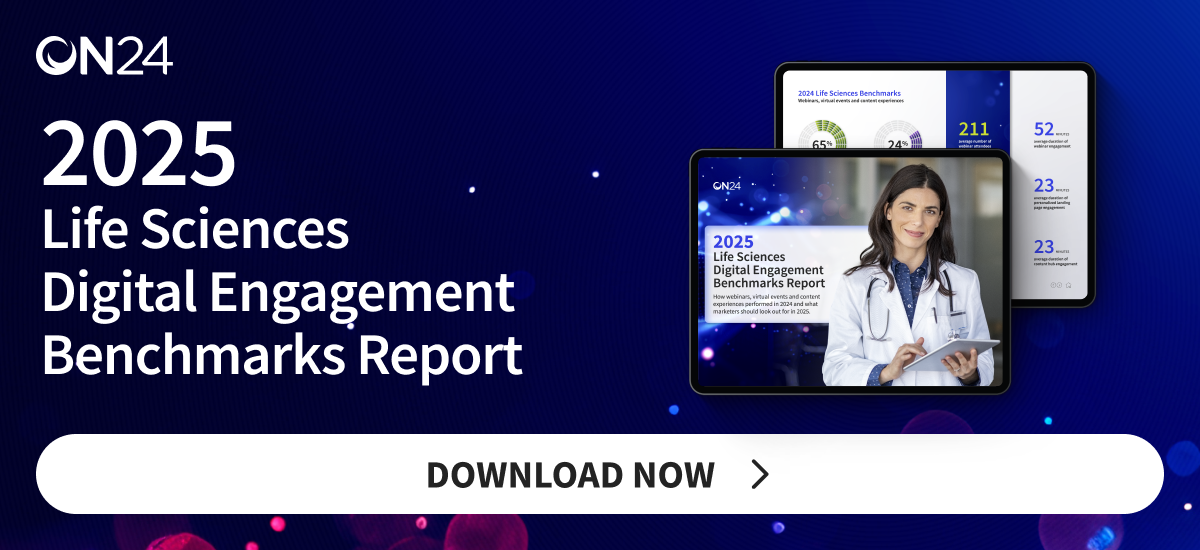Overview
-
Data-rich engagement beats basic metrics
Top teams use first-party engagement insights (not just attendance) to guide content decisions and boost conversions.
-
Interactive, locally tailored experiences deepen connections
Engagement tools, regional content, and native-language delivery significantly increase relevance and credibility with HCPs.
-
Smarter content workflows maximize impact
AI-powered repurposing and always-on content hubs extend the life of webinars, reduce production time, and expand audience reach.
If you’re running webinars or virtual events in life sciences, chances are you’ve hit a few familiar walls. Maybe you’re unsure what’s actually working, because the only metrics you’re seeing are registrations and attendance. Or your team’s burning hours creating content that gets used once and forgotten. Maybe your programs perform well globally — but fall flat locally. And let’s not even talk about how fast your content goes stale.
These aren’t minor annoyances — they’re blockers to real results.
Fortunately, it’s easy to fix these issues. Let’s have a look at some of these challenges and how some life sciences companies are solving them with webinars and virtual events.
You’re flying blind with little to no insight on what’s working

Most teams know the basics: how many people registered, how many attended. But those numbers don’t tell you why something worked or whether your content moved anyone closer to action. Without more in-depth, first-party engagement data, marketers aren’t getting the full picture on how their efforts are performing.
That’s what MilliporeSigma was missing. Without visibility on attendee data, their marketing team couldn’t tell if the content they were producing was valuable or if it was landing with the right people. They are now able to see what individual attendees are interested, how long they stayed engaged and which assets they clicked on or downloaded.
This didn’t just help them prove ROI. It helped them decide what to do next — whether to double down on a product theme, test a new webinar format or skip a topic entirely. This attention to what content works has likely led to the 38% of attendees converting to leads.
You’re sharing content — but not building connections
It’s difficult to get that all-important first-party data if you aren’t engaging with your audiences. Capturing and holding the attention of life sciences audiences is a persistent challenge. They are busy, highly selective with their time and often skeptical of traditional promotional content.
While digital channels are proving to be a great way to build meaningful, data-driven interactions, simply broadcasting information isn’t enough — what’s needed is a way to turn educational content into two-way engagement that’s measurable, relevant and respectful of an HCP’s time.
CSL Behring addressed this by rethinking how it delivered medical education — shifting from static presentations to interactive virtual events tailored to local audiences. In webinars run across LATAM and Asia-Pacific, HCPs were encouraged to engage through live Q&A, polls, and regionally relevant content presented in their native language.
Stuart Davis, Director of Customer Engagement for Marketing, said:
“[These tools] allow you to do different things that make that experience for your customers far more engaging than Teams or Zoom. This is very important because you don’t want a didactic presentation, you want interaction so people stay engaged in what you’re telling them.”

The sessions featured local medical experts, which helped build credibility and relevance. These interactive formats didn’t just improve the learning experience, they also gave CSL Behring’s teams clearer insights into audience interests and behavior, allowing for more informed follow-up and ongoing engagement.
Content creation takes way too long

Content is important when it comes to keeping HCPs , patients, pharma reps and distributors engaged and educated throughout their journey. However, creating content can drain time and resources from already stretched marketing teams.
Generative AI can help with that. ON24 AI-powered ACE helps teams create content — including short videos, blog posts and transcripts — off the back of their virtual events and webinars. This allows teams to maximize the impact of their webinars and multiply their reach.
NRC Health is a great example of a life sciences company that used AI-powered ACE to decrease content creation time by 95%. They are able to create content within hours after their webinars. Specifically, the video content they created from their webinars helps to drive engagement on their website and social media.
Your content has the shelf life of a banana

Another common issue? You run a great webinar, but it and the content you create from it disappears into a black hole afterwards.
Letting your webinar or virtual event fall into the abyss after the live broadcast means you’re likely to miss out on the possibility of a larger audience. With 51% of life sciences audiences viewing webinars on-demand, you’re likely missing out on a larger audience if you let your virtual event or webinar fall into the abyss after the live broadcast.
The solution to this problem is content hubs. These hubs act as a one-stop-shop where HCPs and other visitors can access the webinars, short videos and other content that they are interested in. They are also a great way to guide visitors towards the next action.
The virtual events team at Thermo Fisher Scientific recognized the benefits of having a content hub. Instead of creating new content from scratch every time, they now repurpose their webinars into always-on resources. Using ON24’s Content Hub, they built a digital destination where leads — and customers — can binge content on demand.

Your global programs don’t translate locally

Many life sciences companies operate globally, but marketing internationally can be challenging. Cultural and language differences can present problems if you don’t take them into account. So, how do life sciences companies make content that is locally relevant?
UCB ran into a similar problem. Their global webinars were technically reaching the right people, but they weren’t connecting in the right way. By tailoring content regionally — and using ON24 to manage those versions — they made the program more effective without multiplying the work. This approach has helped lead to high registration and strong attendance.
This approach helped them move from a one-size-fits-all strategy to something more locally relevant, without losing visibility into performance. That kind of balance is hard to achieve, especially when regulatory and scientific content needs local nuance.

The takeaway? You don’t need to overhaul everything — just rethink how you use the tools you already have.
Webinars and virtual events are already part of the life sciences marketing toolkit, but the smartest teams are using them more strategically. They’re building engagement, turning content into ongoing campaigns and using data to guide every decision. Whether you’re trying to reach busy HCPs, streamline content production or prove marketing impact, the opportunity isn’t in doing more — it’s in doing it better.
Want to see more examples of how life sciences companies are using webinars and virtual events to multiply their impact? Check out 17 Digital Experiences That Drive That Drive Omnichannel Engagement for Life Sciences.





